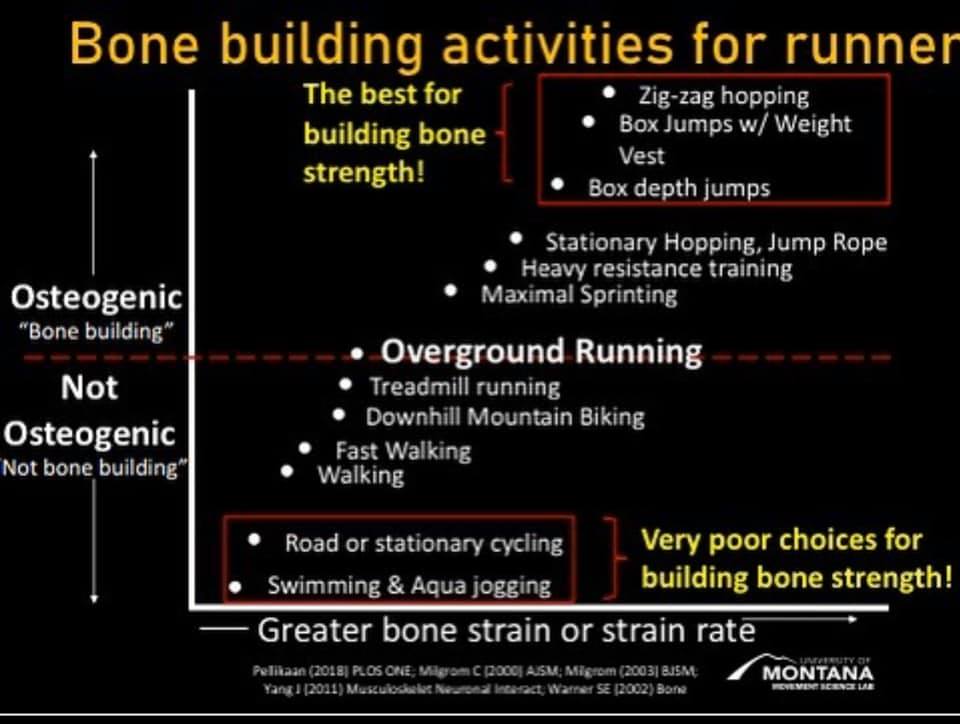Whether you’re training for a marathon or an ultra, meeting the distance of the race during training isn’t always the right answer.
I came across an article from Trailrunner Magazine that matched some of the training philosophies we use at Omega Project. Specifically, when coaching runners, we are always aware of the athlete’s training load. We don’t want their training load to increase too quickly. If it ramps up too much or too fast, there is a risk of injury.
Training load and bone health
When considering an increase in training load, we are looking at the time or mileage of each individual run, the time or mileage of the long run, the intensity of runs throughout the week, and the total weekly time or mileage. Intensity is so important to take into consideration because it captures a part of training that mileage and time alone do not. By considering perceived effort or heart rate during runs, we can make sure the load is ramping up in a healthy way.
Part of not building up the training load too quickly is making sure that the body can handle that load. Does the body have the muscle, connective tissue, and bone strength to handle the load? One of the things that can increase this capacity is strength training. One of the things that can DECREASE this capacity is…running too much.
Our bones, specifically, are constantly going through changes that add cells (osteoclastic) and decrease cells (osteoblastic). These changes occur in response to stress. A lot of people assume that running is good for bone health when it isn’t actually all that great (take a look at the chart below). Bones respond to a new stress in a positive way. For most of us, however, running isn’t new. We are often running many many steps beyond the point of positive return. The article states that anything over 1/2 mile would have diminishing returns for bone health.

Your connective tissues, muscles, and cardiovascular system can continue to adapt to higher loads – if done correctly. Eating well, doing strength training, and following a smart training plan will help to prevent you from running your bones into the ground. Just be aware that running isn’t actually making them stronger.
So what about the long run?
In our training plans for marathons, we often don’t have people run over 3 hours. This is because of what we just discussed above, but also because there really aren’t any more physiological benefits to running over 3 hours. Put another way, you aren’t gaining any more fitness by running over 3 hours but you are putting your bones at risk of stress fractures and other tissues at risk of injury.
Personally, when coaching runners for marathons, I will add something I call “time on your feet” by adding a 15-30-minute brisk walk at the end of the long runs. I’ll add walking throughout the week and at the end of long runs. This is a great way to prepare for the time you will spend on your feet and help you mentally prepare for the time in the race that goes over 3 hours, all without adding more pounding.
Some marathoners and all ultra runners will be running A LOT longer than 3 hours on race day. How do we train for it if 3+ hour runs aren’t that great for us?
My training plans sometimes intersperse walk breaks into the run so the total running time still remains at 3 hours. I also mentioned adding walking to the end of a 3-hour run.
In some cases, when the runner wants to do more than 3 hours, I make sure it has a purpose. I also make sure the runner knows that the purpose is not to increase fitness. The runner may want to run longer to practice nutrition, build mental stamina, or get a feel for the race distance. If this feels like it is a necessary part of your training, plan to have plenty of rest, as if it was a race itself. You may schedule a few days of easy running, or cross-training, or plan out enough weeks of training that you don’t have to do back-to-back weekends of long runs.
When I coached one athlete to a 30-minute marathon PR, we made sure there were several weeks between her 3-hour runs and we did lots of walking for extra miles. In the past, she had always been sidelined by stress fractures and felt it was the long runs that were hardest to recover from. By getting her to the line healthy, she was able to meet her goal and quality for Boston.
In the article, Camille Herron (one of the world’s best ultra runners) has yet another option for training for the distance of ultras. “Studies have found that bone cells start to pay attention to mechanical stress again after a four-to-eight-hour rest period. When you spread the load over multiple sessions rather than one sustained bout, you gain more bone.” Herron will run 10-15 mile long runs and then run a double later that day of 6-7 miles. I don’t often utilize this method with marathoners but it can be an option for ultra runners if you have the time.
Like us, she also stresses adding variety. Our bodies don’t like doing the same thing over and over. It’s important to add things during the week like striders, intervals, and hills.
Overall, be aware that there are a lot of different ways to reach your training goals. Whether you realize it or not, the most important thing is to get to the line healthy. From there, you can go after whatever goals you set your mind to!
Camille Herron’s Advice For Ultra Athletes: Skip the Long Run
If you want access to more advice like this, consider joining the Omega Project Running Club. You’ll have access to training plans on the RunDNA app, quarterly 3D gait screens, group runs, a private Facebook group, and more!
Omega Project Running Club
Love every run with us!
$59/year ($29/year student rate)
Email us at cu*************@************pt.com
Subject Line: SIGN ME UP

